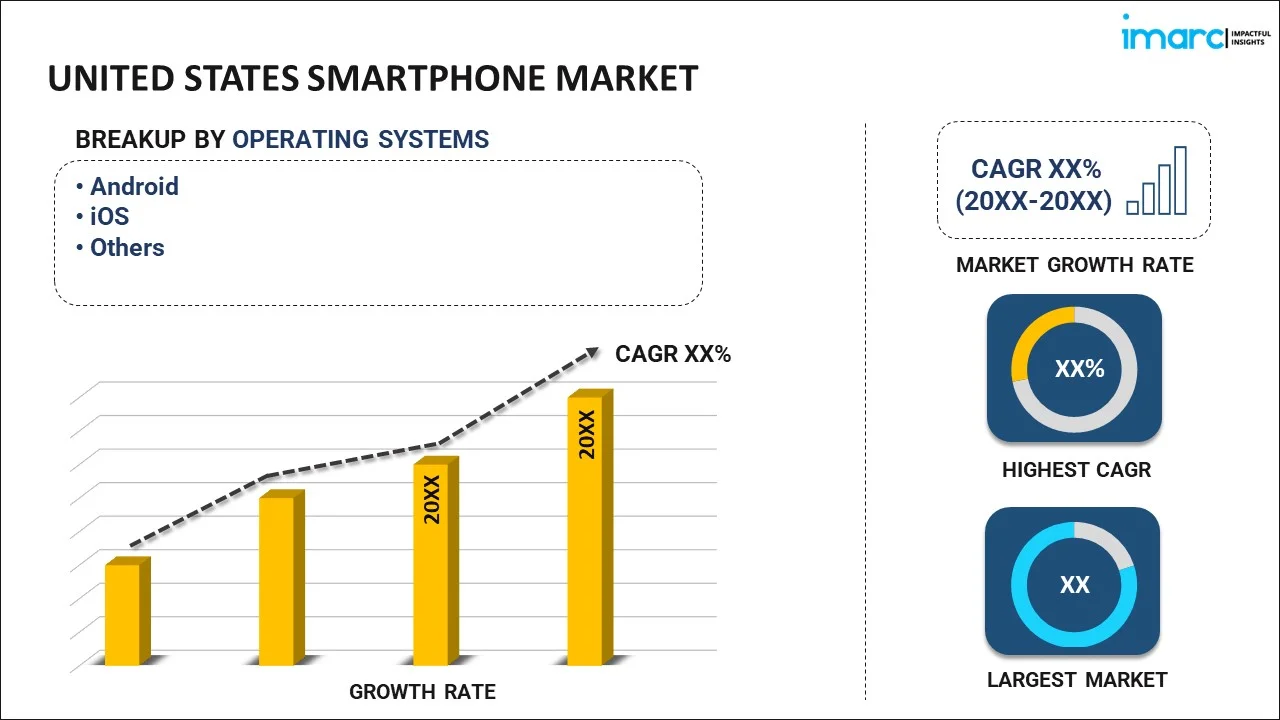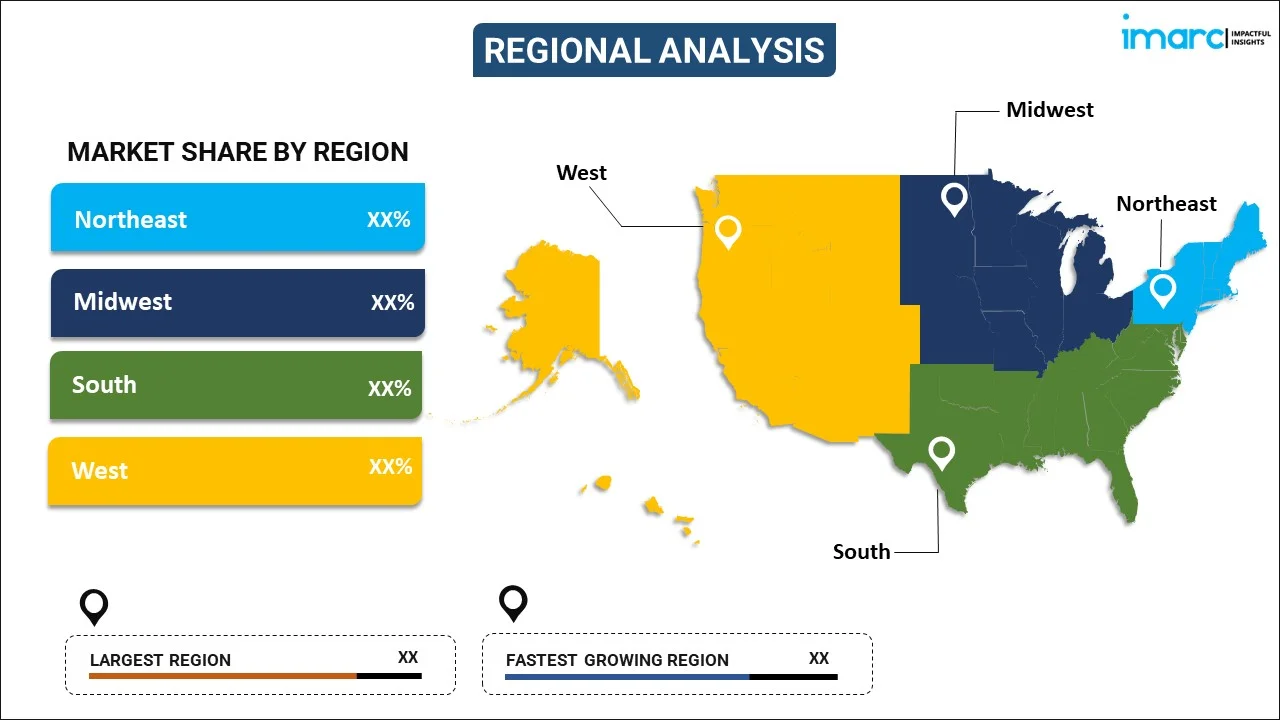
United States Smartphone Market Report by Operating System (Android, iOS, and Others), Display Technology (LCD Technology, OLED Technology), RAM Capacity (Below 4GB, 4GB-8GB, Over 8GB), Price Range (Ultra Low-End (Less Than $100), Low-End ($100-<$200), Mid-Range ($200-<$400), Mid to High-End ($400-<$600), High-End ($600-<$800), Premium ($800-<$1000) and Ultra-Premium ($1000 and Above)), Distribution Channel (OEMs, Online Stores, Retailers), and Region 2026-2034
United States Smartphone Market Size, Share & Outlook:
The United States smartphone market size reached 160.6 Million Units in 2025. Looking forward, IMARC Group expects the market to reach 227.4 Million Units by 2034, exhibiting a growth rate (CAGR) of 3.94% during 2026-2034. The increasing advancements in technology, integration of artificial intelligence (AI) and the internet of things (IoT), proliferation of mobile applications and faster network connectivity represent some of the key factors driving the market.
|
Report Attribute
|
Key Statistics
|
|---|---|
|
Base Year
|
2025 |
|
Forecast Years
|
2026-2034
|
|
Historical Years
|
2020-2025
|
| Market Size in 2025 | 160.6 Million Units |
| Market Forecast in 2034 | 227.4 Million Units |
| Market Growth Rate (2026-2034) | 3.94% |
Access the full market insights report Request Sample
United States Smartphone Market Insights:
- Major Market Drivers: Amplified demand for 5G-capable devices, smartphone penetration growth among various demographics, and growing uses in entertainment, productivity, and communication are major drivers driving the United States smartphone market's continued consumer demand and hardware upgrade cycles.
- Key Market Trends: Growth of foldable smartphones, AI-based features integration, and demands for larger screens and faster refresh rates, all leading to an increasingly personalized and engaging mobile experience.
- Competitive Landscape: The US smartphone market is highly competitive, with players competing on camera capabilities, chipset speed, and software platforms to win over user loyalty, besides competing in mid-range and high-end segments to grow their installed base.
- Challenges and Opportunities: Although upgrade fatigue and market saturation are challenges, there are opportunities in foldable phones, integration of AI, and smartphone demand for sustainability, which enable heightened customer interaction and market diversification among income and age levels.
United States Smartphone Market Trends:
Consumer Transition to 5G Phones
As per United States smartphone market analysis, one of the most characteristic trends for the market is the widespread customer migration towards 5G phones. As 5G networks increase in the urban and suburban areas, consumers are shifting more towards using the faster data rate, reduced latency, and enhanced connectivity-enabled smartphones. The widespread use of cloud gaming, video streaming, and remote work applications additionally demands high-performance network support, propelling the adoption of 5G technology. In addition, 5G phones are being taken up not only by tech consumers but also by mainstream users looking for better performance and future-proofing phones. With 5G coverage becoming widespread, this change is likely to continue its upward movement in all demographic segments. The corresponding effect on unit shipments and upgrade cycles is substantial, straightaway leading to United States smartphone market growth, which keeps gaining from this continuous technological evolution and infrastructure development in the country's digital ecosystem.
Growth of Foldable and Innovative Display Technologies
The launch of foldable smartphones and sophisticated display technologies is defining a new frontier in the high-end segment of the U.S. smartphone market. According to the sources, in June 2025, San Francisco-based technology company Purism released the Liberty Phone, a privacy-oriented smartphone nearly entirely made and built in the United States, with U.S.-developed software and domestically sourced circuit boards. Moreover, customers are being more attracted to products with multi-functional screens, fast refresh rates, and immersive viewing experiences for entertainment and productivity. These products are where the smartphone portability is married with the screen size of a tablet, addressing changing requirements around convenience and multitasking. Advances in flexible OLED panels and hinge longevity enabled these products to be more reliable and business-friendly, particularly among early innovators and tech-savvy professionals. Consequently, phone manufacturers are launching more phones with such models, which is an indication of diversification from traditional flat-screen phones. This style change is in response to the escalating consumer demand for exclusive and feature-laden smartphones, introducing a premium touch to the market. Such innovation is being seen more in the United States smartphone market share, especially in high-value consumer groups.
Growing Integration of AI-Powered Features in Smartphones
Artificial intelligence is increasingly becoming a central feature of contemporary smartphones in the US, powering features that improve user experience, device performance, and security. From AI-driven photography and voice recognition to smart battery management and predictive app behavior, AI features are now deeply integrated into operating systems and chipsets. Users are moving towards smartphones that provide smart automation, including contextual notifications, real-time language translation, and on-device learning. This trend runs in parallel with larger cultural changes toward personalization and the adoption of smart technology. The requirement for AI-enabled smartphones is also underpinned by advancements in edge computing, enabling phones to handle data processing more efficiently and securely. As these are a standard feature across mid-range and high-end devices, they have a material impact on buying decisions and user expectations. The growing penetration of such features reflects wider United States smartphone market trends, leading to differentiation and competitive advantage in a mature yet highly dynamic technology market.
United States Smartphone Market Segmentation:
IMARC Group provides an analysis of the key trends in each segment of the United States smartphone market report, along with forecasts at the country level for 2026-2034. Our report has categorized the market based on operating system, display technology, RAM capacity, price range and distribution channel.
Operating System Insights:

To get detailed segment analysis of this market Request Sample
- Android
- iOS
- Others
The report has provided a detailed breakup and analysis of the market based on the operating system. This includes android, iOS, and others.
Display Technology Insights:
- LCD Technology
- OLED Technology
A detailed breakup and analysis of the market based on the display technology has also been provided in the report. This includes LCD technology and OLED technology.
RAM Capacity Insights:
- Below 4GB
- 4GB-8GB
- Over 8GB
A detailed breakup and analysis of the market based on the RAM capacity has also been provided in the report. This includes below 4GB, 4GB-8GB and over 8GB.
Price Range Insights:
- Ultra Low-End (Less Than $100)
- Low-End ($100-<$200)
- Mid-Range ($200-<$400)
- Mid to High-End ($400-<$600)
- High-End ($600-<$800)
- Premium ($800-<$1000) and Ultra-Premium ($1000 and Above)
A detailed breakup and analysis of the market based on the price range has also been provided in the report. This includes ultra low-end (less than $100), low-end ($100-<$200), mid-range ($200-<$400), mid to high-end ($400-<$600), high-end ($600-<$800) and premium ($800-<$1000) and ultra-premium ($1000 and Above).
Distribution Channel Insights:
- OEMs
- Online Stores
- Retailers
A detailed breakup and analysis of the market based on the distribution channel has also been provided in the report. This includes OEMs, online stores, and retailers.
Regional Insights:

To get detailed regional analysis of this market Request Sample
- Northeast
- Midwest
- South
- West
The report has also provided a comprehensive analysis of all the major regional markets, which include the Northeast, Midwest, South and West.
Competitive Landscape:
The report has also provided a comprehensive analysis of the competitive landscape in the market. Competitive analysis such as market structure, key player positioning, top winning strategies, competitive dashboard, and company evaluation quadrant has been covered in the report. Also, detailed profiles of all major companies have been provided.
Latest News and Developments:
- In July 2025, Samsung unveiled the Galaxy Z Fold 7, Galaxy Z Flip 7, and Galaxy Z Flip 7 FE, which launched with improved foldable features of bigger screens and deeper AI integration. The phones show Samsung's ongoing commitment to upgrading premium smartphones and endeavor to enhance its position in the competitive foldable smartphone space.
- In June 2025, the Trump Organization introduced Trump Mobile, a new domestic U.S.-based mobile service and smartphone brand. Introduced at Trump Tower, the venture features a domestically manufactured device and functions on top U.S. networks, emphasizing a move towards American-built technology and increased consumer choice within the competitive smartphone marketplace.
- In April 2025, Motorola introduced its new Razr smartphones—the Razr, Razr+, and Razr Ultra—into the United States market, emphasizing cutting-edge AI integration with Gemini, Copilot, and Perplexity. With improved durability, distinct designs, and AI-enabled pre-installed features, the launch solidifies Motorola's competitive foothold in the U.S. premium foldable smartphone industry.
Report Coverage:
| Report Features | Details |
|---|---|
| Base Year of the Analysis | 2025 |
| Historical Period | 2020-2025 |
| Forecast Period | 2026-2034 |
| Units | Million Units |
| Scope of the Report | Exploration of Historical and Forecast Trends, Industry Catalysts and Challenges, Segment-Wise Historical and Predictive Market Assessment:
|
| Operating Systems Covered | Android, iOS, Others |
| Display Technologies Covered | LCD Technology, OLED Technology |
| RAM Capacities Covered | Below 4GB, 4GB-8GB, Over 8GB |
| Price Ranges Covered | Ultra Low-End (Less Than $100), Low-End ($100-<$200), Mid-Range ($200-<$400), Mid to High-End ($400-<$600), High-End ($600-<$800), Premium ($800-<$1000) and Ultra-Premium ($1000 and Above) |
| Distribution Channels Covered | OEMs, Online Stores, Retailers |
| Regions Covered | Northeast, Midwest, South, West |
| Customization Scope | 10% Free Customization |
| Post-Sale Analyst Support | 10-12 Weeks |
| Delivery Format | PDF and Excel through Email (We can also provide the editable version of the report in PPT/Word format on special request) |
Key Benefits for Stakeholders:
- IMARC’s report offers a comprehensive quantitative analysis of various market segments, historical and current market trends, market forecasts, and dynamics of the United States smartphone market from 2020-2034.
- The research study provides the latest information on the market drivers, challenges, and opportunities in the United States smartphone market.
- Porter's five forces analysis assist stakeholders in assessing the impact of new entrants, competitive rivalry, supplier power, buyer power, and the threat of substitution. It helps stakeholders to analyze the level of competition within the United States smartphone industry and its attractiveness.
- Competitive landscape allows stakeholders to understand their competitive environment and provides an insight into the current positions of key players in the market.
Key Questions Answered in This Report
The smartphone market in the United States reached 160.6 Million Units in 2025.
The United States smartphone market is projected to exhibit a (CAGR) of 3.94% during 2026-2034, reaching a volume of 227.4 Million Units by 2034.
Major drivers in the United States smartphone market are heightened consumer demand for 5G connectivity, strengthening adoption of AI-enabled features, and increased smartphone dependency for business, entertainment, and online transactions. Furthermore, ongoing innovation in design, display technology, and camera capabilities improves user experience, leading to shorter upgrade cycles and market expansion across income and age groups.
Need more help?
- Speak to our experienced analysts for insights on the current market scenarios.
- Include additional segments and countries to customize the report as per your requirement.
- Gain an unparalleled competitive advantage in your domain by understanding how to utilize the report and positively impacting your operations and revenue.
- For further assistance, please connect with our analysts.
 Request Customization
Request Customization
 Speak to an Analyst
Speak to an Analyst
 Request Brochure
Request Brochure
 Inquire Before Buying
Inquire Before Buying




.webp)




.webp)












